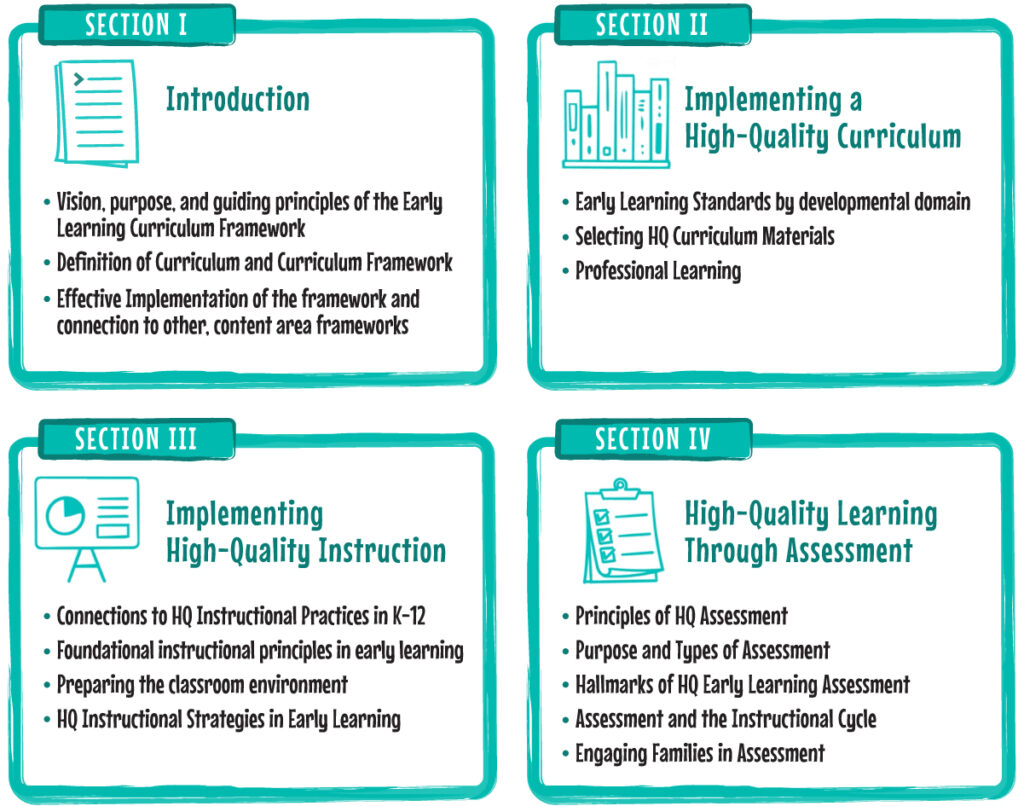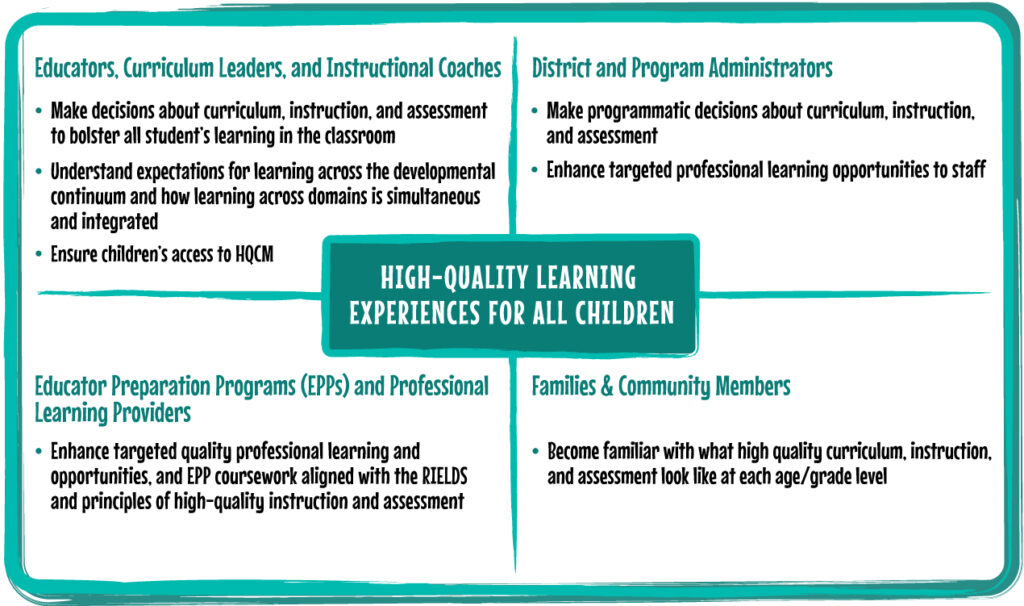Section 1: Introduction
Early Learning Context in Rhode Island
In the 2020-21 school year there were approximately 70,220 children ages Birth through age five in Rhode Island. 39% (27,344) of these children reside in one of the state’s four core cities, consisting of Central Falls, Pawtucket, Providence, and Woonsocket. As of the 2021-22 school year, 30.5% (21,459) of the Birth through Five population were enrolled in a licensed community-based early learning program, child care or family childcare home, 1.7% (1,205) in Head Start, and 4% (2,834) received preschool services in Rhode Island public schools (RI KIDSCOUNT, 2022). The Department of Human Services, who oversees these licensed programs, works collaboratively with RIDE to ensure early learning programs throughout the state continuously increase quality and improve the education provided to children aged birth through 5. Through the BrightStars Quality Rating and Improvement System (QRIS), both center-based and Family Child Care providers are encouraged to increase their star rating (quality rating), in turn receiving higher child care subsidy rate.
RI Pre-K
RI Pre-K provides free, high-quality Pre-K education to eligible four-year-old children. RI Pre-K is offered through a unique, mixed-delivery model comprised of Head Start programs, local education agencies/school districts, and community-based childcare providers. RI Pre-K programs are awarded through a competitive grant application process that evaluates the organization’s demonstrated ability and experience to provide a high-quality early childhood program and a commitment to continued quality improvements. Providing access to voluntary, free, high-quality pre-kindergarten programs is a strategy proven to help close the achievement gaps that are noticeable even before children enter school and to provide increased educational opportunities to students.
Multilingual Learners
The term “multilingual learners” (MLLs) refers to the same population in federal policy as English learners (ELs). All early childhood settings across Rhode Island are responsible for supporting MLLs in cultivating cultural, linguistic, and intellectual strengths through integrated content and language instruction, enrichment opportunities, and a whole-child approach to teaching and learning.
Early Intervention
Children under the age of three are eligible for EI if they have a “single established condition” known to lead to developmental delay (e.g., very low birth weight, Down Syndrome, etc.) or if they have a significant developmental delay in one or more areas of development. One of the goals of EI is to provide support to families so their children can develop to their fullest potential and to best accomplish this, services are provided in places where children usually play or take part in daily activities. Anyone may refer a child to EI such as a pediatrician, social worker, childcare provider, friend, or family member. Referrals for EI should be made directly to the individual Early Intervention agency listed here.
Early Childhood Special Education
Early Childhood Special Education is a federal and state mandated program for young children with developmental delays and disabilities. It refers to the range of special education services that apply specifically to children between the ages of 3 and 5, prior to Kindergarten. The Individuals with Disabilities Education Act (IDEA) and the Rhode Island Regulations Governing the Education of Children with Disabilities ensure that all children with disabilities, including children with developmental delays, who require special education to meet their educational needs are provided with appropriate public education (FAPE) in the least restrictive environment (LRE) in accordance with their individual needs. To be eligible for special education children must be referred, evaluated, and determined eligible for services. This document describes the process of responding to referrals, conducting evaluations, and determining eligibility in alignment with the Division for Early Childhood (DEC) Recommended Practices.
Vision for Student Success in Early Learning

RIDE envisions an educational landscape in which all children in Rhode Island will enter Kindergarten developmentally, social-emotionally, and educationally ready to succeed, putting them on a path to read proficiently by 3rd grade (ECCE Strategic Plan, 2021).
From birth, children are curious and primed for learning. Child growth and development is particularly rapid during the first five years of life and are influenced by a complex combination of factors including all of their interactions with the physical and social world (Kupcha-Szrom, 2011; Center on the Developing Child, 2012). RIDE envisions high-quality early learning environments and curricula as having a focus on the whole child, recognizing that development is integrated, and occurs simultaneously across all domains. It is through play-based learning experiences that children will develop, generate knowledge of the larger world, and begin to acquire qualities for lifetime learning. As such, the goal of the Early Learning framework is to create conditions in which all of our state’s youngest learners will have the opportunity to be immersed in a play-based environment supported by high– quality curriculum, instruction, and assessment practices that are aligned with the Rhode Island Early Learning and Development Standards (RIELDS).
Through continued interagency collaboration with the Department of Human Services, Department of Health, Department of Children, Youth, and Families, the Executive Office of Health and Human Services, and the Governor’s Office, RIDE will establish research-based policy and guidance to build a strong foundation for early learners’ future education, relationships, and development.
Purpose
The purpose of the Early Learning framework is to provide guidance to educators, curriculum leaders, instructional coaches, district and program administrators, educator preparation providers and professional learning providers, and family and community members around the implementation of the Rhode Island Early Learning and Development Standards (RIELDS), particularly as it relates to the design and use of curriculum materials, instruction, and assessment for programs serving children ages Birth through five. The framework streamlines a vertical application of standards and assessment across the early learning continua, increase opportunities for all children to engage in developmentally appropriate learning experiences, and ultimately support educators and families in making decisions that prioritize children’s learning. These uses of the curriculum frameworks align to the overarching commitment to ensuring all children have access to high-quality and developmentally appropriate curriculum, instruction, and assessment that prepares them to succeed in kindergarten and beyond.
Success Criteria
- Equitably and effectively support the learning of all students, including multilingual learners and differently-abled students.
- Support and reinforce the importance of culturally responsive and sustaining education practices.
- Prepare students to thrive and succeed in college and/or careers.
Guiding Principles for Rhode Island’s Frameworks
The following five guiding principles are the foundation for Rhode Island’s Early Learning Curriculum Framework. The guiding principles speak to the coherence of an educational system grounded in rigorous standards. This framework integrates recommendations and resources that are evidence-based, specific to the standards, support the needs of all learners – including multilingual learners and differently-abled students, and link to complementary RIDE policy, guidance and initiatives to create a vision of a coherent, high-quality, educational system.
The Guiding Principles for the Early Learning Framework are intended to frame the guidance within this document around the use and implementation of standards to drive curriculum, instruction, and assessment within a multitiered system of supports (MTSS). These principles include the following:
What is ‘Curriculum’?
RIDE has previously defined curriculum as a “standards-based sequence of planned experiences where students practice and achieve proficiency in content and applied learning skills. Curriculum is the central guide for all educators as to what is essential for teaching and learning so that every student has access to rigorous academic experiences.” Building off of this definition, RIDE also identifies specific components that comprise a complete curriculum. These include the following:
Goals within a curriculum are the standards-based benchmarks or expectations for teaching and learning. Most often, goals are made explicit in the form of a scope and sequence of skills to be addressed. Goals must include the breadth and depth about what a student is expected to learn.
Methods are instructional decisions, approaches, and routines that teachers use to engage all students in meaningful learning. These choices support the facilitation of learning experiences to promote a student’s ability to understand and apply content and skills. Methods are differentiated to meet student needs and interests, task demands, and learning environment. They are also adjusted based on ongoing review of student progress towards meeting the goals.
Materials are the tools and resources selected to implement methods and achieve the goals of the curriculum. They are intentionally chosen to support a student’s learning, and the selection of resources should reflect student interest, cultural diversity, world perspectives, and address all types of diverse learners. To assist childcare centers, family childcare homes, Head Starts, and Pre-Kindergarten programs, and other early childhood programs across the state with the curriculum selection process, RIDE identified an “Approved List of Pre-Kindergarten Curricula.” The intent of this list is to provide programs with the ability to choose a high-quality curriculum that best fits the needs of its students, teachers, and community and is aligned with the Rhode Island Early Learning and Development Standards (RIELDS) as well as a department-developed rubric to demonstrate alignment to the expectations for high-quality curriculum in the State. See the “Selecting High-Quality Materials” section on page 18 for more information on RI’s List of Approved Curricula for Children ages 3-5 years.
Assessment in a curriculum is the ongoing process of gathering information about a student’s learning. This includes a variety of ways to document what the student knows, understands, and can do with their knowledge and skills. Information from assessment is used to make decisions about instructional approaches, teaching materials, and academic supports needed to enhance opportunities for the student and to guide future instruction.

Another way to think about curriculum, and one supported by many experts, is that a well-established curriculum consists of three interconnected parts all tightly aligned to standards: the intended (or written) curriculum, the lived curriculum, and the learned curriculum (e.g., Kurz, Elliott, Wehby, & Smithson, 2010). Additionally, a cohesive curriculum should ensure that teaching and learning is equitable, culturally responsive, and offers students multiple means through which to learn and demonstrate proficiency.
The written curriculum refers to the learning experiences and other supports included in the curriculum guide. This aligns with the ‘goals’ and ‘materials’ components described above. Given this, curriculum materials (lesson plans, books, learning activities) do not comprise a curriculum on their own, but rather are the resources that help to implement it. They also establish the foundation of students’ learning experiences. The written curriculum should provide students with opportunities to engage in learning experiences that build on their background experiences and cultural and linguistic identities while also exposing students to new experiences and cultural identities outside of their own. The written curriculum is crucial in building a foundation for high-quality learning; however, it is important to remember that it is only as good as how it is used and/or implemented.
The lived curriculum refers to everything that children actually experience in the learning setting, including how the teacher delivers curriculum, how children experience the curriculum, and how learning is assessed. In other words, the lived curriculum is defined by the quality of instructional practices that are applied when implementing the written curriculum. This aligns with the “methods” section in RIDE’s curriculum definition. The lived curriculum must promote instructional engagement by affirming and validating students’ home culture and language as well as provide opportunities for integrative and interdisciplinary learning. Learning experiences should be instructed through an equity lens, providing all children with a rich, high-quality learning experience.
Finally, the learned curriculum refers to how much of and how well the intended curriculum is learned and how fully students meet the learning goals as defined by the standards. This is often defined by the validity and reliability of assessments, as well as by student achievement, their work, and performance on tasks. The learned curriculum should reflect a commitment to the expectation that all students can access and attain widely held developmental milestones aligned with the RIELDS. Ultimately, the learned curriculum is an expression and extension of the written and lived curriculum and should promote critical consciousness in both educators and students, providing opportunities for educators and students to improve systems for teaching and learning in the school community.
Key Takeaways
- First, the written curriculum (goals and HQCMs) must be firmly grounded in the standards and include a robust set of HQCMs that all teachers know how to use to design and implement instruction and assessment for students.
- Second, the characteristics of a strong lived curriculum include consistent instructional practices and implementation strategies that take place across classrooms that are driven by standards, evidence-based practices, learning tasks for students that are rigorous and engaging, and a valid and reliable system of assessment.
- Finally, student learning and achievement are what ultimately define the overall strength of a learned curriculum, including how effectively students are able to meet the standards.
What is a Curriculum Framework?
The early learning and K-12 content area frameworks are designed to provide consistent guidance around how to use standards to support the selection and use of high-quality curriculum materials, evidence-based instructional practices, as well as valid and reliable assessments – all in an integrated effort to equitably maximize learning for all students. The curriculum frameworks can also be used to inform decisions about appropriate foci for professional learning, certification, and evaluation of active and aspiring teachers and administrators.
The curriculum frameworks include information about research-based, culturally responsive, and equitable pedagogical approaches and strategies for use during implementation of high-quality curriculum materials and assessments to scaffold, develop, and assess the skills, competencies, and knowledge called for by the state standards.
Organization of the Curriculum Frameworks
Section 1 is the introduction of the curriculum framework.
Section 2 lists the standards and provides a range of resources to help educators understand and apply them. Section 2 also addresses how standards support the selection and implementation of high-quality curriculum materials.
Section 3 provides guidance and support around building high-quality, standards-aligned instruction in the early learning classroom.
Section 4 offers resources and support for using high-quality, standards-aligned early learning assessment.
In sum, each curriculum framework, in partnership with high-quality curriculum materials, informs decisions at the classroom, school/program, and district/community level about curriculum material use, instruction, and assessment in line with current standards and with a focus on facilitating equitable and culturally responsive learning opportunities for all students.
Summary of Section Structure

What does effective implementation of the Curriculum Framework look like?
The primary audiences for the information and resources in the Early Learning Curriculum Framework are educators in Rhode Island who make decisions and implement practices that impact students’ opportunities for learning in line with standards. This means that the primary audience includes educators, instructional leaders, education coordinators, and district and program administrators.
Below are examples of how RIDE envisions the guidance and resources within this framework being used. These examples are not exhaustive by any measure and are intended to give early childhood stakeholders an initial understanding of how to practically begin thinking about how to implement and use this framework to inform their daily practice.

Overview and Connection to Other Frameworks
RIDE has developed curriculum frameworks for a variety of K-12 content areas including mathematics, science and technology, ELA/literacy, History and Social Studies, World Languages, and the arts. While the Early Learning framework addresses the comprehensive development of children across content areas, there is coherence across all curriculum frameworks, including a common grounding in principles focused on connections to content standards and providing equitable and culturally responsive learning opportunities through curriculum resources, instruction, and assessment. The curriculum frameworks also explicitly connect to RIDE’s work in other areas including, but not limited to, multilingual learners, differently-abled students, college and career readiness, and culturally responsive and sustaining practices. Below is a brief overview of how this and the other curriculum frameworks are organized, as well as a summary of how the specific curriculum frameworks overlap and connect to each other.
Connections to Other RIDE Resources
This curriculum framework is designed to be a valuable resource for educators and families. It is intended to support early childhood program providers in developing a robust and effective system of teaching and learning. To achieve this, it also connects users to the vast array of guidance and resources that the RIDE has and will continue to develop. Thus, when logical, direct references are made, including direct hyperlinks, to any additional resources that will help educators, families, and community members implement this framework.
- References
Kurz, A., Elliott, S. N., Wehby, J. H., & Smithson, J. L. (2010). Alignment of the Intended, Planned, and Enacted Curriculum in General and Special Education and Its Relation to Student Achievement. The Journal of Special Education, 44(3), 131-145. Retrieved from Alignment-of-the-Intended-Planned-and-Enacted-Curriculum-in-General-and-Special-Education-and-Its-Relation-to-Student-Achievement.pdf (researchgate.net)
Rhode Island Department of Elementary and Secondary Education. (2021). Together Through Opportunity: Pathways to Student Success: Rhode Island’s Strategic Plan for PK-12 Education, 2021-2025. Retrieved from RIDEStrategicPlan_2021-2025.pdf.
